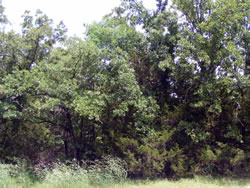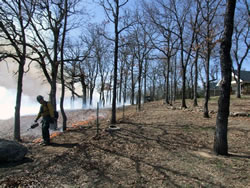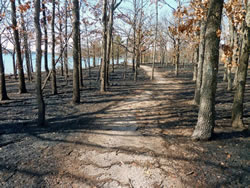National Cohesive Wildland Fire Management Strategy Success Story
Prairie Restoration Underway
Chickasaw National Recreation Area, Oklahoma
Cohesive Strategy - Maintain and Restore Landscapes
2011

Eastern red cedar creates a wildfire hazard, displaces other species from the natural ecosystem, impairs local air quality by producing allergens, and contributes to the general decline of the local water table.

The National Park Service's prescribed fire program helps protect local communities from the catastrophic effects of uncontrolled wildland fires while promoting the natural ecosystem's ability to thrive.

This eastern red cedar reduction project will open up views around the park, improve wildlife habitat, reduce wildfire hazard, conserve water in the Arbuckle Simpson aquifer, and reduce pollen levels.
In February 2011, fire managers treated approximately 2,184 acres of Chickasaw National Recreation Area with prescribed fire. They were part of the final phase of a multi-month, $1.4 million American Recovery and Reinvestment Act (ARRA) project to reduce eastern red cedar and restore native grasslands in the park.
The prescribed fires were conducted in the Point, Nature Center, Five Lakes, and Upper Guy Sandy areas of the park to help reduce eastern red cedar slash that had been cut by a contractor in the fall and summer of 2010. Eastern red cedar creates a wildfire hazard, displaces other species from the natural ecosystem, impairs local air quality by producing allergens, and contributes to the general decline of the local water table. Under natural conditions eastern red cedar is limited by periodic natural fires.
As part of the National Park Service's prescribed fire program, these managed fires help protect local communities from the catastrophic effects of uncontrolled wildland fires while promoting the natural ecosystem's ability to thrive. Prescribed fires improve forest health by promoting nutrient recycling, increasing habitat diversity, and reducing fuels that lead to unwanted, out-of-control wildfires. Habitat improvement from the fires will contribute to increases in species such as deer and turkey and thereby improve hunting opportunities.
Residents near these burn areas also will benefit because the fuel from dead plant material that has accumulated over the years is reduced under favorable conditions. This significantly reduces the threat a wildfire would pose to people and property in and near the park. Thinning of the eastern red cedar will increase public safety by reducing the hazardous fuel load in the wildland-urban interface, moving the ecosystem closer to a natural state.
Contact
Bruce Fields, Fire Management Officer
Email: Bruce_Fields@nps.gov
Phone: (806) 865-3360 x426
Keywords: American Recovery and Reinvestment Act